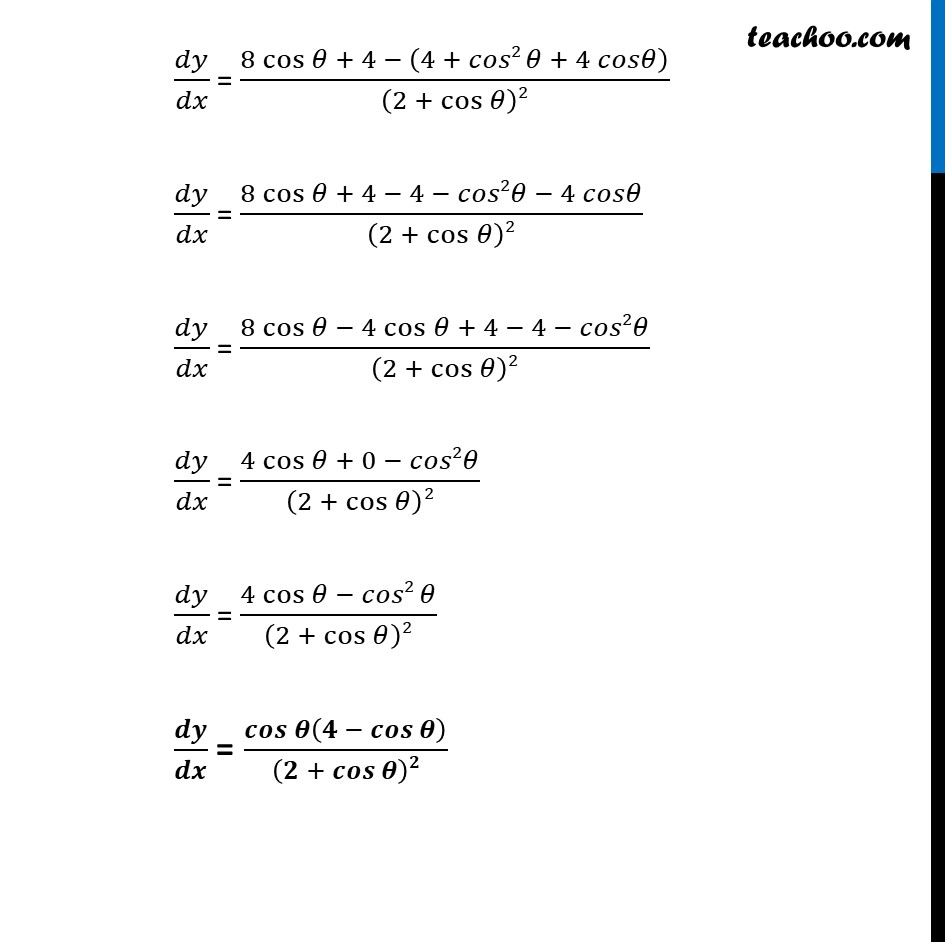




Ex 6.2
Ex 6.2,2
Ex 6.2,3 Important
Ex 6.2,4
Ex 6.2, 5 Important
Ex 6.2, 6 (a)
Ex 6.2, 6 (b) Important
Ex 6.2, 6 (c) Important
Ex 6.2, 6 (d)
Ex 6.2, 6 (e) Important
Ex 6.2, 7
Ex 6.2,8 Important
Ex 6.2,9 Important You are here
Ex 6.2,10
Ex 6.2,11
Ex 6.2, 12 (A)
Ex 6.2, 12 (B) Important
Ex 6.2, 12 (C) Important
Ex 6.2, 12 (D)
Ex 6.2, 13 (MCQ) Important
Ex 6.2,14 Important
Ex 6.2,15
Ex 6.2, 16
Ex 6.2,17 Important
Ex 6.2,18
Ex 6.2,19 (MCQ) Important
Last updated at April 16, 2024 by Teachoo





Ex 6.2, 9 Prove that 𝑦 = (4 sin𝜃)/((2 +〖 cos〗〖𝜃)〗 ) – θ is an increasing function of θ in[0,𝜋/2] . 𝑦 = (4 sin𝜃)/((2 + cos𝜃 ) )−𝜃 We need to prove that function is increasing function of θ in (0 , 𝜋/2) i.e. we need to prove that 𝒅𝒚/(𝒅𝜽 ) > 0 for θ ∈ [𝟎 , 𝝅/𝟐] Differentiating w.r.t θ 𝑑𝑦/(𝑑𝜃 ) = 𝑑/𝑑𝜃 ((4 sin𝜃)/(2 + cos𝜃 ) −𝜃) 𝑑𝑦/(𝑑𝜃 ) = 𝑑/𝑑𝜃 ((4 sin𝜃)/(2 +cos𝜃 ) )− 𝑑𝜃/𝑑𝜃 𝑑𝑦/(𝑑𝜃 ) = 𝑑/𝑑𝜃 ((4 sin𝜃)/(2 +cos𝜃 ) )− 1 𝑑𝑦/𝑑𝑥 = ((𝟒 𝒔𝒊𝒏𝜽 )^′ (𝟐 + 𝒄𝒐𝒔𝜽 ) − (𝟐 + 𝒄𝒐𝒔𝜽 )^′ (𝟒 𝒔𝒊𝒏𝜽 ))/(𝟐 + 𝒄𝒐𝒔𝜽 )𝟐 −1 𝑑𝑦/𝑑𝑥 = (4 cos𝜃 (2 + cos𝜃 ) − (0 − sin𝜃 )(4 sin𝜃 ))/(2 + cos𝜃 )2 −1 𝑑𝑦/𝑑𝑥 = (8 cos〖𝜃 + 4 (𝒄𝒐𝒔𝟐𝜽 + 𝒔𝒊𝒏𝟐𝜽)〗)/(2 + cos𝜃 )2 −1 𝑑𝑦/𝑑𝑥 = (8 cos〖𝜃 + 4(𝟏)〗)/(2 + cos𝜃 )2 −1 𝑑𝑦/𝑑𝑥 = (8 cos〖𝜃 + 4〗 − (2 + cos𝜃 )2)/(2 + cos𝜃 )2 Using quotient rule as (𝑢/𝑣)^′= (𝑢^′ 𝑣 − 𝑣^′ 𝑢)/𝑣2 Where u = 4 sin𝜃 & 𝑣= 2+cos𝜃 𝑑𝑦/𝑑𝑥 = (8 cos〖𝜃 + 4〗 − (4 + 𝑐𝑜𝑠2 𝜃 + 4 𝑐𝑜𝑠𝜃))/(2 + cos𝜃 )2 𝑑𝑦/𝑑𝑥 = (8 cos〖𝜃 + 4〗 − 4 − 𝑐𝑜𝑠2𝜃 − 4 𝑐𝑜𝑠𝜃)/(2 + cos𝜃 )2 𝑑𝑦/𝑑𝑥 = (8 cos〖𝜃 − 4 cos𝜃 + 4 − 4 − 𝑐𝑜𝑠2𝜃〗)/(2 + cos𝜃 )2 𝑑𝑦/𝑑𝑥 = (4 cos 𝜃 + 0 − 𝑐𝑜𝑠2𝜃)/(2 + cos𝜃 )2 𝑑𝑦/𝑑𝑥 = (4 cos〖𝜃 − 𝑐𝑜𝑠2 𝜃〗)/(2 + cos𝜃 )2 𝒅𝒚/𝒅𝒙 = (𝒄𝒐𝒔𝜽 (𝟒 − 𝒄𝒐𝒔𝜽 ))/(𝟐 + 𝒄𝒐𝒔𝜽 )𝟐 For the function to be increasing 𝑑𝑦/𝑑𝜃 > 0 (𝐜𝐨𝐬𝜽 (𝟒 − 𝒄𝒐𝒔𝜽 ))/(𝟐 + 𝒄𝒐𝒔𝜽 )𝟐 > 0 Since denominator is a square, We need to show that cos θ (𝟒−𝐜𝐨𝐬𝜽 ) > 0 for θ ∈ [0 , 𝜋/2] Now, 0 ≤ cos θ ≤ 1 Multiplying by –1 –1 ≤ –cos θ ≤ 0 Adding 4 both sides –1 + 4 ≤ – cos θ + 4 < 0 + 4 3 ≤ 4 – cos θ < 4 Thus, (4 – cos θ) is positive And, cos θ is also positive Hence, cos θ (4 – cos2 θ) is also positive ∴ cos θ (4 – cos2 θ) > 0 for θ ∈ [0 , 𝜋/2 ] Hence 𝑦 = (4 sin𝜃)/(2 +cos𝜃 ) – θ is an increasing function for θ ∈ [𝟎 , 𝝅/𝟐]